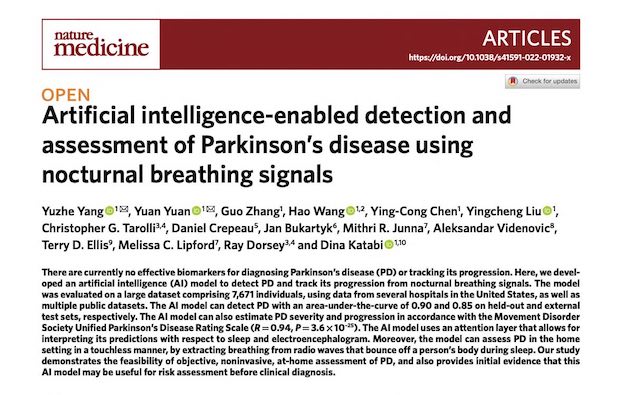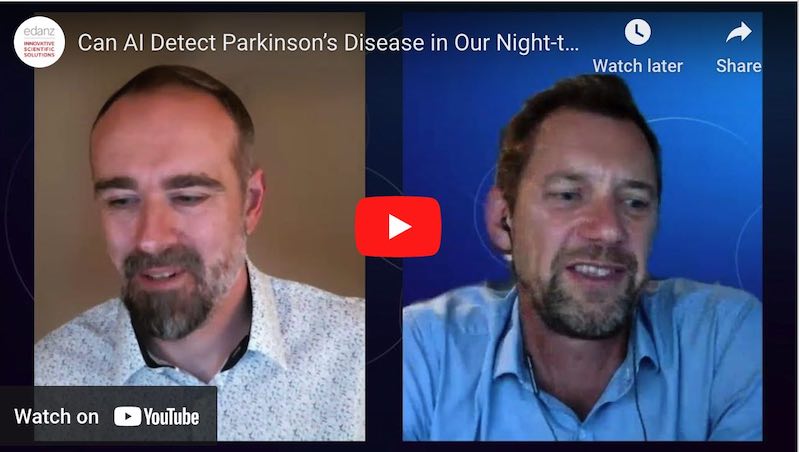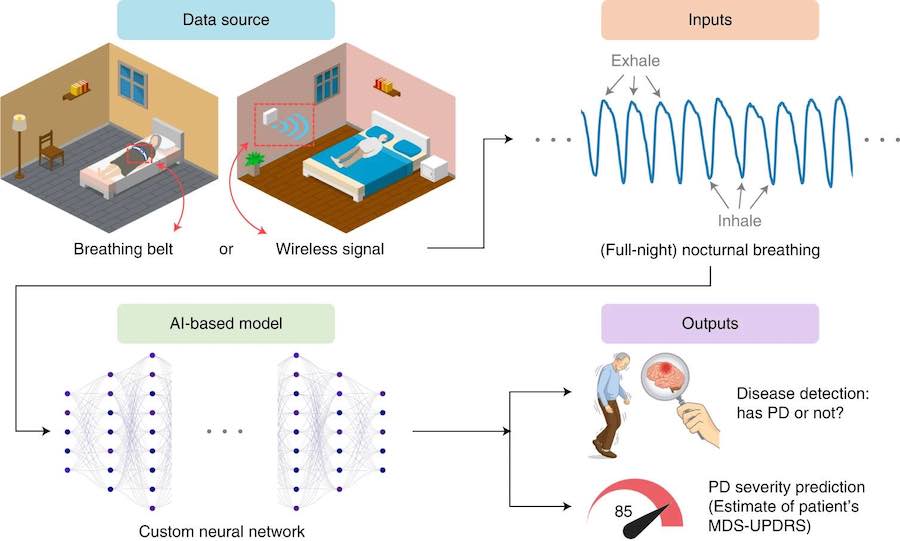Parkinson’s disease affects tens of millions of people worldwide. A promising new study suggests that it may be possible to detect PD before severe symptoms occur. But how? Enter artificial intelligence! In this episode of Excited by the Science, our experts discuss a new way to detect Parkinson’s disease in its early stages using AI to analyze our breathing while we sleep.
Host Julian Tang welcomes expert panelists Daniel McGowan and James Graham to discuss the exciting science behind the article, "Artificial intelligence-enabled detection and assessment of Parkinson’s disease using nocturnal breathing signals" (Yang, et al.)
 |
James Graham PhD, CMPP • Scientific Director, Edanz
PhD in Biochemistry with a research background in prions and Parkinson's disease (The Roslin Institute and DZNE Bonn)
|
 |
Daniel McGowan, PhD, MInstD • CEO, Cure Parkinson's New Zealand
Life sciences and medical communications professional with 25+ years' experience in R&D, innovation, sci/med comms, senior management and governance.
|
https://www.nature.com/articles/s41591-022-01932-x
DOI: https://doi.org/10.1038/s41591-022-01932-x

WATCH

Click to watch the video -- it will open in a new tab of your browser
LISTEN

Click to listen to the podcast -- it will open in a new tab of your browser
READ
The need for early detection of Parkinson's disease (PD)
Parkinson's disease (PD) is a degenerative disorder of the central nervous system. It often impairs the sufferer's motor skills, speech, and other functions. PD affects one in every 100 people aged 60+ worldwide, though it also impacts a younger demographic – noted actor Michael J. Fox was diagnosed at just 30.
PD is caused by the death of nerve cells in a specific area of the brain known as the substantia nigra, which controls movement. When this part of the brain deteriorates, patients can experience symptoms such as tremors, rigidity, slowed movement, and difficulty balancing.
PD also has no known cure, but early detection and effective treatment can significantly improve patients’ lives.
Using AI to detect PD
Artificial intelligence (AI) has been explored for detecting and assessing PD, with moderate success. Recently, however, a team of US-based researchers (Yang et al.) made a breakthrough. They used AI to analyze nighttime breathing signals to detect Parkinson’s.
“This is an incredibly exciting paper. It represents a leap forward in PD research,” says Edanz Science Director Dr. James Graham. “PD is notoriously difficult to detect. This study, however, provides evidence that AI can identify people who have PD from their nocturnal breathing. It can also assess disease severity and progression with high accuracy.”
The researchers reported their findings in the journal Nature Medicine. Yuzhe Yang, a PhD student at the MIT Computer Science and Artificial Intelligence Laboratory (CSAIL) and Dr Yuan Yuan, a postdoctoral research associate in the same laboratory, serve as co-corresponding authors of the study. The two researchers share a common research interest in machine learning, computer vision and AI for healthcare.

Image source: Yang, Y., Yuan, Y., Zhang, G. et al. Artificial intelligence-enabled detection and assessment of Parkinson’s disease using nocturnal breathing signals. Nat Med 28, 2207–2215 (2022). https://doi.org/10.1038/s41591-022-01932-x
The researchers tracked PD’s progression from nighttime breathing signals. The analyzed data on a large cohort of more than 7,000 patients from several US hospitals and public databases. Notably, the AI model could detect PD with an area-under-the-curve of 0.90 and 0.85 on held-out and external test sets, respectively. This AI model could also estimate PD severity and progression per the Movement Disorder Society Unified Parkinson’s Disease Rating Scale.
“The novel digital biomarker for PD unveiled in this study was based on a rich and diverse set of data. It operates both as a diagnostic and a progression biomarker,” Dr. Daniel McGowan, CEO of Cure Parkinson’s New Zealand, points out. “The biomarker is not limited by either the patient’s or clinician’s subjectivity. It’s also non-invasive and easy to use in the home setting. Measurements can be collected every night in a contactless way.”
“The advantage of using AI [in this case] is that you can take multiple data points and aggregate them to determine whether PD is present or not in an individual,” Graham adds. He highlights the limitations of current methods used in detection of PD. One major challenge is tracking people in rural areas, who may have less access to healthcare facilities.
Next steps toward a brighter future for Parkinson’s patients
Nonetheless, more work needs to be done to widely deploy AI in this area.
Yang and colleagues, in their study, acknowledged PD is a non-homogeneous disease with many subtypes. So, future studies must also consider this aspect of PD. And while the current system’s ability to separate PD from Alzheimer’s disease was demonstrated, its ability to separate PD from other neurological diseases has yet to be investigated. Also, the development and progression of respiratory symptoms in PD were only partially understood. Those require further investigation.
“While I think that the diagnosis of PD would still require human expertise, AI detection can certainly be a trigger for a person who doesn’t know they’re at risk of PD—or even have PD—to seek medical attention,” McGowan says. “There’s a real need for such biomarkers.”
“There are several major organizations focusing their research efforts on AI for PD early detection and disease monitoring,” Graham adds. “A study from the University of Cambridge examined how AI can be used to analyze changes in the brain that may indicate the early stages of PD, and a smartphone app that can pick up really subtle changes in an individual’s handwriting that may reflect the disease’s presence.”
There’s much to look forward to in terms of advances in understanding and tackling PD. This study represents a major step in the development of new biomarkers for the disease. Its findings will hopefully inspire other researchers to gain new clinical insights into detection and treatment of PD.
Watch the full video or listen to the full podcast below to find out more about the experts’ views on the study and the latest developments in PD research.
SHARE THE EXCITEMENT